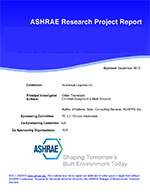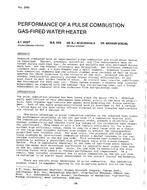Click here to purchase
Airflow in buildings is one of the major factors that governs the interaction of the building structure with the mechanical system, climate, and occupants. If the airflow at any point within a building or building assembly can be determined or predicted, the temperature and moisture (hygrothermal or psychometric) conditions can also be determined or predicted. If the hygrothermal conditions of the building or building assembly are known, the performance of materials can also be determined or predicted. This paper shows that airflow in buildings is complex, time dependent, and multidirectional. The understanding of airflow through and within buildings has been based on the requirement for continuity of mass and momentum caused by wind forces, thermal effects (stack action), and forces associated with the operation of mechanical cooling, heating, exhaust, and other ventilation systems. Interstitial airflow and interstitial air pressure fields are not often considered. Building analysis typically develops the building pressure field from the airflow field. In doing so, exterior and interior walls, floors, and roof assemblies are either considered as monolithic or having openings resulting in flow across the specific assemblies. This paper shows that many problems associated with pollutant transfer and the spread of smoke and fire cannot be explained by cross-assembly (one-dimensional) airflow as well as such moisture effects as microbial contamination, corrosion, and biological decay. Even the analysis of energy consumption and comfort within buildings needs to be considered in terms of multidirectional airflow. This paper shows that buildings typically comprise multi-layer envelope assemblies with numerous air gaps or void spaces that are often connected to service chases. Complex three-dimensional flow paths and intricate air pressure relationships must be considered. This paper also introduces an alternative pattern of analysis: developing the flow field, the leakage areas, and the flow relationships from the measured building pressure field– the air pressure regime within and surrounding the building. This approach accounts for interstitial air pressure fields and resulting interstitial airflows. It provides a powerful diagnostic tool for solving many of the problems related to direct and indirect effects of airflows.
AUTHOR: Joseph W. Lstiburek, P. Eng.
CITATION: Thermal Performance of the Exterior Envelopes of Buildings VII
KEYWORDS: December, Florida, 1998
YEAR: 1998
Citation: Thermal Performance of the Exterior Envelopes of Buildings VII
Product Details
- Published:
- 1998
- File Size:
- 1 file , 1.3 MB
- Product Code(s):
- D-8049


